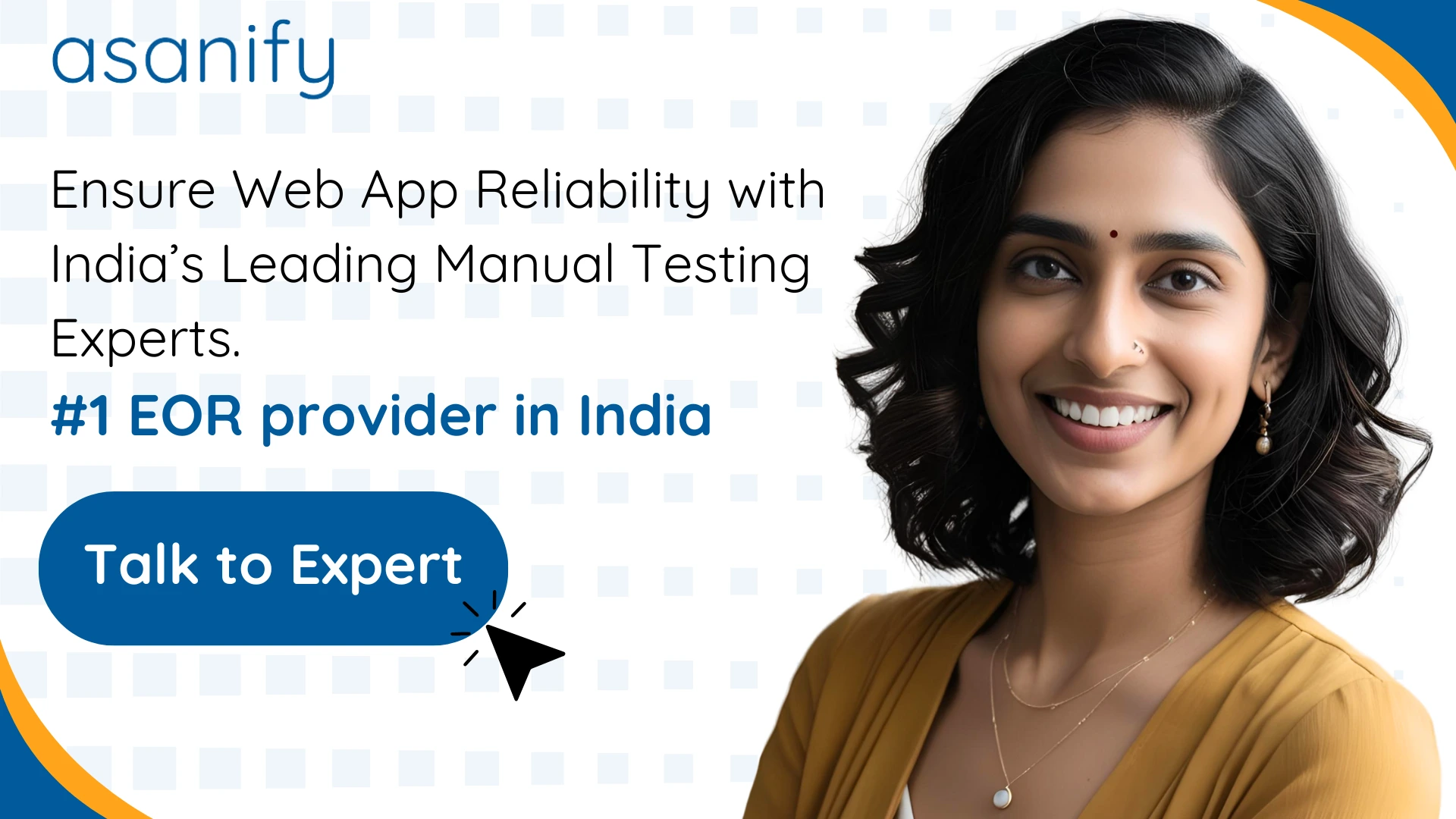India has long been recognized as a global hub for IT services and technology talent. In 2025, this remains especially true for software quality assurance, where Indian manual testers offer an unbeatable combination of cost-efficiency, skill, and scalability. Whether you’re a startup validating an MVP or an established SaaS company running Agile sprints, hiring manual testers in India can enhance your QA processes, reduce time-to-market, and help uncover bugs before they become customer complaints.
This guide offers a detailed overview for global product teams looking to hire manual testers in India—covering skills, salaries, hiring models, legal compliance, and how EOR providers like Asanify can make the hiring journey effortless and fully compliant.
Table of Contents
- Introduction
- Why Hire Manual Testers from India in 2025?
- What Does a Manual Tester Do?
- Tools Manual Testers Commonly Use
- Average Manual Tester Salaries in India (2025)
- How to Hire Manual Testers in India: Key Models
- When to Choose EOR (Employer of Record)
- Why Use Asanify to Hire Manual Testers in India?
- Use Cases for Hiring Manual Testers in India
- Legal & HR Compliance When Hiring in India
- How Asanify Ensures Full Compliance
- Final Thoughts: Building Your QA Team in India
- FAQs
Why Hire Manual Testers from India in 2025?
The demand for reliable QA professionals continues to rise as software development cycles accelerate and product teams move toward continuous integration and delivery (CI/CD). India stands out as a prime location to source highly capable manual testers who can keep up with evolving QA needs.
Abundance of Skilled QA Professionals
India boasts a talent pool of over 5 million IT professionals, with a significant portion specializing in software testing. These professionals often hold degrees in computer science or engineering and are trained in structured QA methodologies. Many have experience working with global product teams, and are well-versed in manual testing best practices, such as test case creation, exploratory testing, and structured defect reporting. Their fluency in English also makes collaboration smooth and effective.
Cost Advantage Without Compromising Quality
One of the most compelling reasons to hire from India is the cost savings. Compared to hiring QA engineers in North America, Europe, or Australia, Indian manual testers can deliver similar—if not better—output at significantly lower costs. These savings don’t come at the expense of quality; Indian testers are known for their attention to detail, domain expertise, and thorough test documentation.
Time Zone Flexibility and Global Collaboration
Indian manual testers are used to working across multiple time zones, whether it’s overlapping with EST for US-based teams or collaborating during EMEA business hours. This flexibility allows you to run extended QA cycles, improve test coverage, and shorten release timelines. With the rise of remote tools, testers in India integrate seamlessly into daily stand-ups, sprint reviews, and testing workflows.
What Does a Manual Tester Do?
A manual tester plays a crucial role in the software development lifecycle by acting as the last line of defense before code reaches production. Their role is far more than just “clicking through” an application—they think like end-users, uncover usability flaws, and ensure all business requirements are met.
Key Responsibilities
Manual testers are responsible for executing test cases manually to identify bugs or inconsistencies in software applications. They simulate user interactions, verify features against requirements, and document their findings in issue tracking systems. Their typical tasks include:
- Designing detailed test plans and test cases
- Performing functional, regression, smoke, and exploratory testing
- Identifying and logging bugs with precise replication steps
- Collaborating with developers, product managers, and UX teams
- Participating in Agile ceremonies to provide QA feedback early

Tools Manual Testers Commonly Use
Here are the popular tools Indian manual testers rely on:
| Category | Common Tools in India (2025) |
| Test Management | TestRail, Zephyr, QMetry, Xray |
| Bug Tracking | JIRA, Bugzilla, MantisBT |
| Documentation | Confluence, Google Sheets, Excel |
| Communication | Slack, Zoom, Microsoft Teams |
These tools help testers document test cases, report bugs, communicate with dev teams, and maintain audit trails.
Average Manual Tester Salaries in India (2025)
Indian manual testers remain cost-effective hires for global companies without compromising on quality. Here’s a breakdown by experience:
| Experience Level | Monthly Salary (INR) | Annual Salary (USD) |
| Junior (0–2 years) | ₹25,000 – ₹40,000 | $3,600 – $5,800 |
| Mid-Level (3–5 years) | ₹50,000 – ₹80,000 | $7,000 – $11,500 |
| Senior (6–10 years) | ₹90,000 – ₹1,50,000 | $13,000 – $21,000 |
| Lead QA (10+ years) | ₹1,60,000+ | $23,000+ |
Salaries vary based on the tester’s domain (e.g., fintech, edtech, SaaS), city (metro vs. tier-2), and exposure to international projects. Despite inflation, Indian QA salaries are still significantly more affordable than in Western markets.
Suggested Read: Hire Laravel Developers in India: The Ultimate 2025 Guide
How to Hire Manual Testers in India: Key Models
There are multiple ways to hire Indian QA talent, and your choice will depend on budget, compliance needs, and project timelines.
In-House vs Freelance vs EOR Hiring
| Model | Pros | Cons |
| In-House Hiring | Total control, long-term employee retention | Legal entity setup, compliance overhead |
| Freelance | Fast, flexible, short-term engagements | Variable quality, IP risk, lack of commitment |
| EOR (e.g., Asanify) | Fast, compliant, full-time engagement | Slightly higher cost than freelance |
When to Choose EOR (Employer of Record)
Choosing an Employer of Record (EOR) is an ideal strategy for companies looking to expand their QA capabilities in India without navigating the complex and time-consuming process of establishing a legal entity. An EOR acts as the legal employer of your manual testers while you retain full operational control over their day-to-day tasks, responsibilities, and performance expectations. This model is especially beneficial for businesses that prioritize agility, compliance, and rapid market entry.
EOR is best suited for companies that:
- Want to avoid the hassle and expense of incorporating in India
Setting up a legal entity requires months of paperwork, regulatory approvals, and ongoing administrative effort. With an EOR, you can bypass incorporation altogether and begin operations immediately through a fully compliant partner. - Need compliant payroll and HR processes from day one
India has a complex legal framework governing employment, taxes, and employee benefits. An EOR ensures that all employment contracts, payroll deductions, and social security contributions like Provident Fund (PF) and Employee State Insurance (ESI) are handled accurately and in full compliance with local labor laws. - Prefer to test the market before building a local team
Companies often want to validate product-market fit or assess the effectiveness of a QA presence in India before making long-term commitments. An EOR allows you to explore the Indian market risk-free, providing a temporary yet fully compliant employment framework that can later be scaled or converted into a permanent setup. - Require quick onboarding of manual testers for immediate QA needs
Whether you’re dealing with a tight release schedule, a sudden increase in testing workload, or the need to meet compliance and security standards, an EOR enables fast hiring—often within 3–5 business days. This allows teams to maintain velocity without cutting corners on quality assurance.

What EOR Enables
With an EOR in place, you retain full control over your testers’ daily work—assigning tasks, participating in sprint ceremonies, and integrating them into your product development workflows. Meanwhile, the EOR partner manages all the backend responsibilities, including:
- Drafting legally compliant employment agreements
- Processing monthly payroll and tax deductions
- Managing statutory contributions and benefits
- Handling employee onboarding, leave tracking, and exit procedures
- Ensuring accurate recordkeeping and government filings
This combination of operational freedom and administrative support makes EOR the preferred model for global product teams aiming to scale their quality assurance function in India without delays or legal risks.
Why Use Asanify to Hire Manual Testers in India?
Asanify is a top Employer of Record (EOR) platform in India that helps global teams hire, manage, and pay manual testers quickly and compliantly. It handles employment contracts, INR payroll, taxes, and statutory benefits like Provident Fund and gratuity, ensuring full compliance with Indian labor laws. The platform supports fast onboarding—often within 3–5 business days—through digital document verification and automated workflows. Asanify also offers access to a vetted talent pool of manual testers skilled in Agile, mobile, and web testing. By partnering with staffing agencies and QA communities, it ensures you get qualified candidates with practical testing experience. With built-in tools for onboarding, leave tracking, and final settlements, Asanify removes HR complexities so you can focus on product development. It’s the ideal solution for companies looking to scale their QA function in India without setting up a local entity or navigating legal and administrative hurdles.
Use Cases for Hiring Manual Testers in India
Manual testing is essential across industries and company stages. Common use cases include:
MVP Testing for Startups
Before releasing your MVP to users, it’s critical to ensure stability, usability, and feature coverage. Indian testers provide structured bug reports and usability insights to help founders polish early-stage products.
Continuous QA for Agile Teams
Agile teams benefit from having manual testers on hand during every sprint. Whether it’s regression testing before deployment or verifying new features, Indian QA professionals integrate well into CI/CD pipelines and collaborative workflows.
Legal & HR Compliance When Hiring in India
India’s labor regulations can be complex for foreign companies. These include statutory contributions, employment rules, and local benefits frameworks.
Key Labor Regulations to Know
When hiring Indian testers, ensure compliance with:
- Employment contracts with clauses on probation, termination, and notice
- Statutory benefits: Provident Fund (PF), Employee State Insurance (ESI)
- Bonus eligibility under the Payment of Bonus Act
- Gratuity obligations after 5 years of service
- Minimum wage laws based on job role and city

How Asanify Ensures Full Compliance
Asanify ensures end-to-end compliance with Indian labor laws by automating every critical aspect of the employment and HR process for global companies. The platform creates fully compliant digital contracts that adhere to Indian statutory requirements, including clauses for probation, termination, notice periods, and benefits. It accurately calculates and deducts applicable taxes, Provident Fund (PF), Employee State Insurance (ESI), and other mandatory social security contributions from employee salaries. Asanify also tracks and manages employee leave balances, generates detailed payslips each month, and maintains secure records for audits. Most importantly, it handles all government filings and statutory returns on your behalf—such as PF, professional tax, and income tax declarations—ensuring your company stays compliant without needing to navigate India’s complex regulatory landscape. This allows you to focus on building your product and scaling your QA operations while Asanify takes care of the legal and administrative burden.
Suggested Read: Hire Magento Developers in India: The Ultimate 2025 Guide
Final Thoughts: Building Your QA Team in India
India remains one of the most attractive destinations for hiring QA professionals in 2025. Its combination of skilled talent, affordable rates, and remote work readiness makes it an ideal partner for global companies. Whether you need one manual tester or a full QA team, platforms like Asanify help you scale with confidence—compliantly, quickly, and affordably.
With the right QA team in place, you can ship faster, catch more bugs, and deliver a flawless product experience to your users.
FAQs
Junior testers earn around ₹25,000/month ($3,600 annually), while senior testers may earn up to ₹1.5 lakh/month ($21,000 annually). Salaries vary by city, experience, and domain expertise.
Use an Employer of Record (EOR) like Asanify. They act as the legal employer, handling compliance and payroll, while you manage the tester’s work.
Strong attention to detail, test case writing, regression testing, bug reporting, and communication. Familiarity with tools like JIRA, TestRail, and Zephyr is also key.
Popular tools include JIRA, Bugzilla, TestRail, Zephyr, Excel, Confluence, and Slack. These tools help manage test cycles, report issues, and collaborate with dev teams.
Yes, but you must follow local labor laws. Hiring through an EOR ensures full compliance with Indian employment regulations and tax laws.
Asanify handles job offers, onboarding, payroll, tax filings, and employment contracts. They also provide ongoing HR support and manage benefits on your behalf.
EOR ensures legal compliance, full-time commitment, long-term reliability, and smoother onboarding. Freelance platforms offer short-term access but with higher turnover and IP risks.
Yes. Asanify supports flexible hiring arrangements including fixed-duration contracts, freelance-to-full-time conversions, and project-based testers.
Typically within 3–5 business days, depending on candidate availability and document processing.
Yes. Many Indian testers adjust their work schedules to match US, UK, and APAC time zones. This ensures real-time collaboration and quick feedback loops.
Not to be considered as tax, legal, financial or HR advice. Regulations change over time so please consult a lawyer, accountant or Labour Law expert for specific guidance.



